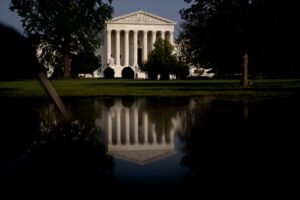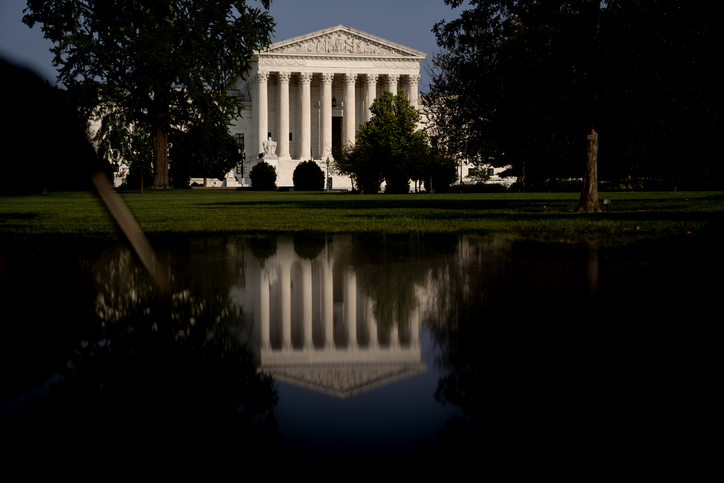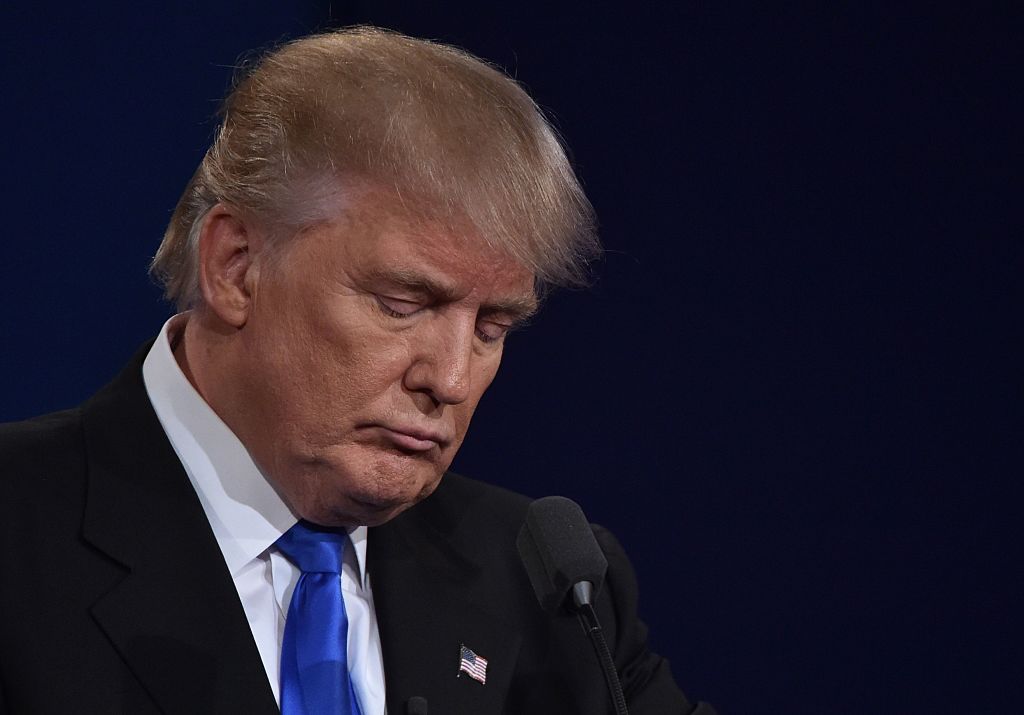
(Photographer: Stefani Reynolds/Bloomberg)
Joe Biden is now — belatedly — on the Supreme Court term limits train. It’s almost embarrassing to approvingly quote The West Wing at this point, but “let’s forget the fact that you’re coming a little late to the party and embrace the fact that you showed up at all,” might be the only pop culture reference to capture the moment.
After pushing off reform in favor of a wheel-spinning commission, the Supreme Court’s embrace of radical Calvinball in Trump v. United States prompted the president to put in a call to Professor Laurence Tribe, who first proposed statutory term limits a decade back when Democrats assumed Hillary Clinton would win the White House and secure a stranglehold on the Court for decades to come. As a reform measure, term limits addresses the underlying cause of the Court’s institutional rot in ways no other reform really can. Politicization of the Court? Legitimacy of dead-hand presidential influence? Even the Court’s ethical cesspool stems from the justices feeling entitled to gifts in exchange for taking a government salary for life.
Biden now seems to be Tribe-pilled. With Kamala Harris having signaled support, term limits is now table stakes for Democratic candidates.
Naysayers have sprung into action, insisting that term limits are impossible without a constitutional amendment in a bid to shut down any attempt at court reform. This campaign to smother good faith discussion in the crib argues that term limits requires changing the text of Article III’s “shall hold their Offices during good Behaviour” language, which is traditionally read to mean “for life.”
A constitutional amendment is, admittedly, a logistical non-starter. Despite term limits enjoying massive, bipartisan support, the amendment process is onerous by design. And no one really expects a statutory term limits proposal attempting to redefine “good Behaviour” would survive muster. Which is only notable to the extent it puts the lie to the cynical lie of “Originalism.” At the time of the Founding, the phrase “good Behaviour” enjoyed a history as a term of art in English law meaning a tenure that was not “at the pleasure of the Crown.” A term limits regime that operates by a term of years as opposed to the pleasure of the president would reasonably fall within the original public meaning of that phrase. But “original” only matters when it’s a convenient fig leaf for contemporary Republican policies.
But most term limits proposals don’t revoke life tenure and do not turn on “removing” an existing justice. The action in term limits scholarship turns on two congressional powers that are unquestioningly granted by the explicit text of the Constitution: setting the number of Supreme Court justices and limiting and regulating the appellate jurisdiction of the Court.
First, that Congress can set the size of the Supreme Court isn’t controversial. They’ve changed the number of justices by statute multiple times since the Founding. Nothing constrains the size of the Court either. If Congress exercised its power to “ordain and establish” the structure of the Court to provide for a new justice every two years with no cap on membership, that’s entirely within its power.
Second, the Supreme Court draws upon two wells for its authority. Original jurisdiction is a constitutional responsibility of the Supreme Court. “Cases affecting Ambassadors, other public Ministers and Consuls, and those in which a State shall be Party,” must be heard by all the justices appointed to the Supreme Court. So, if this proposal were to pass and no justice dies or otherwise leaves the Court over the next 10 years, then Clarence Thomas still gets to vote on the 14-justice panel deciding some water rights dispute between Texas and Oklahoma.
But beyond those explicitly defined cases, the jurisdiction of the Supreme Court is set by congressional statute.
In all the other Cases before mentioned, the supreme Court shall have appellate Jurisdiction, both as to Law and Fact, with such Exceptions, and under such Regulations as the Congress shall make.
Congress could, by statute, limit this jurisdiction to the most recently appointed nine justices — an “appellate panel” if you will. This represents the overwhelming majority of what we consider “Supreme Court cases.” The only case to address the scope of the statutory power to make “such Exceptions” is Ex Parte McCardle. Let’s turn to Professor Christopher Sprigman for this one:
In its 1869 decision in Ex Parte McCardle, the Court gave effect to a jurisdiction-stripping provision, holding that “[w]ithout jurisdiction the court cannot proceed at all in any cause” and refusing to inquire whether Congress was motivated to strip jurisdiction by the desire to insulate unconstitutional legislation from review. “We are not at liberty,” the McCardle Court held, “to inquire into the motives of the legislature. We can only examine into its power under the Constitution; and the power to make exceptions to the appellate jurisdiction of this court is given by express words.”
One could argue that jurisdiction stripping — while undoubtedly statutory — must apply to the whole Court and could not be limited to only the longer tenured justices. This would do violence to the second half of the constitutional text: Congress can make both “Exceptions” and “Regulations” for how the Court exercises appellate jurisdiction. It’s difficult to craft an explanation for “Regulations” being anything but surplusage if it didn’t cover such a limitation.
That said, Ian Millhiser of Vox dismisses the constitutional text on practical grounds:
But let’s be realistic. If Congress does enact an ordinary law imposing term limits on the justices, the constitutionality of that law would ultimately be resolved by the Supreme Court. And unlike, say, Donald Trump’s arguments that he was allowed to commit crimes while he was president, the argument that justices serve for life actually has a strong basis in the Constitution’s text.
They might! It’s also not an argument against pursuing term limits.
Again, there’s is no plausible argument against adding justices to the Court by statute since it’s been done repeatedly. Could the Court finagle a reading divorced of both text (Exceptions and Regulations) and precedent (McCardle) to nix or curtail the appellate jurisdiction prong, there remains a solution.
Just nakedly expand the Court. Add four (or more) justices and simply wipe out the current majority’s influence. Because zero Court reform happens without a “trifecta” election where Democrats control the House, Senate, and White House. And if they have the trifecta required to pass these term limits proposals, they have the trifecta required to send another 10 justices to the Court.
Popular discourse around FDR’s court packing effort often brands it a failure because he didn’t end up adding justices to the Court. But his threat to expand the Court ended with the “switch in time that saved nine.” Roosevelt didn’t care about expanding the Court, he cared about winning an interbranch political squabble and he did when the conservative justices blocking his New Deal programs blinked.
Substantively, Court expansion is a bad court reform. It doesn’t solve the rot flowing from life tenure and runs the risk of spiraling into destabilizing tit-for-tat where the whole legal landscape wildly swings on every trifecta election.
Without accompanying term limits, expanding the Court as a first action suffers from a legitimacy problem. Whether you believe it was Gorsuch’s seat or Barrett’s seat that was stolen, the conservatives “should” still enjoy a 5-4 majority under the existing process. It’s one thing to objectively reject justices giving long gone presidents outsized dead-hand influence based on the vagaries of life expectancy and another to accept that model and just add people to flip the Court your way.
That said, if the justices cynically reject a wildly popular term limits proposal, the public will lose a lot of sympathy.
To quote the immortal Jimmy Malone:
They pull a knife, you pull a gun. He sends one of yours to the hospital, you send one of his to the morgue. That’s the Chicago way!… Now do you want to do that? Are you ready to do that?
It’s not whether expanding the Court is a good idea, it’s whether or not reformers are ready to follow through if the Court rejects statutory term limits. You don’t need a constitutional amendment, but you do need to be willing to take drastic measures if forced.
As Malone put it, “What are you prepared to do?”
Earlier: Biden Considers Supreme Court Term Limits Roughly 3 Years Too Late
Supreme Court Term Limits Still The Only Reform That Matters
 Joe Patrice is a senior editor at Above the Law and co-host of Thinking Like A Lawyer. Feel free to email any tips, questions, or comments. Follow him on Twitter if you’re interested in law, politics, and a healthy dose of college sports news. Joe also serves as a Managing Director at RPN Executive Search.
Joe Patrice is a senior editor at Above the Law and co-host of Thinking Like A Lawyer. Feel free to email any tips, questions, or comments. Follow him on Twitter if you’re interested in law, politics, and a healthy dose of college sports news. Joe also serves as a Managing Director at RPN Executive Search.
#Supreme #Court #Term #Limits #Dont #Require #Constitutional #Amendment.. #Require #Hardball










